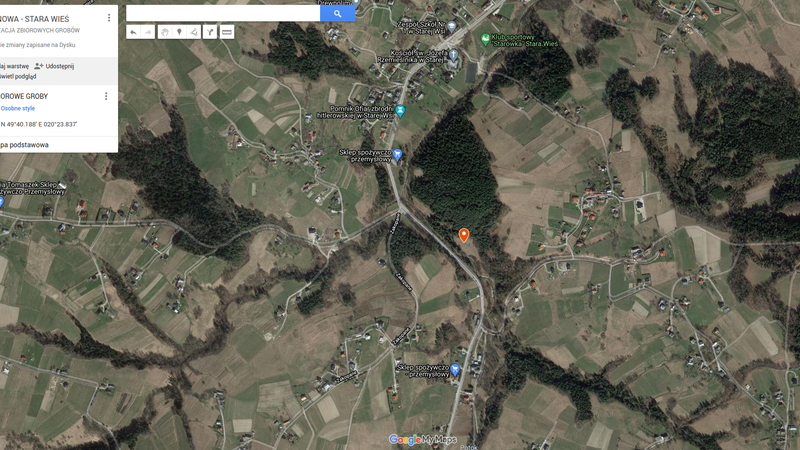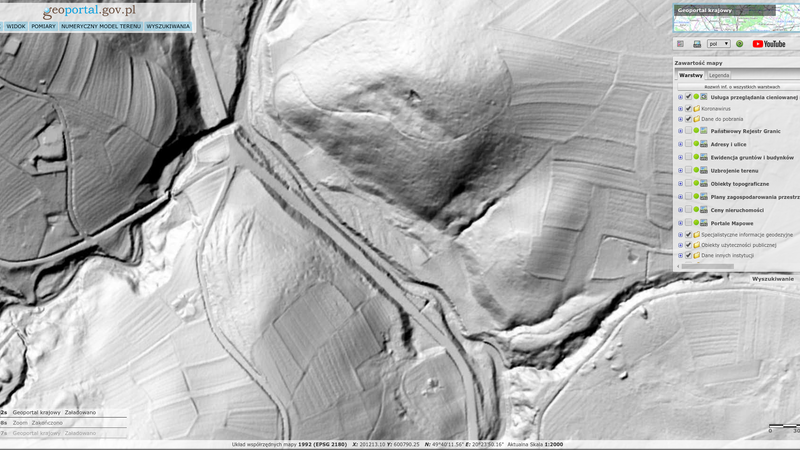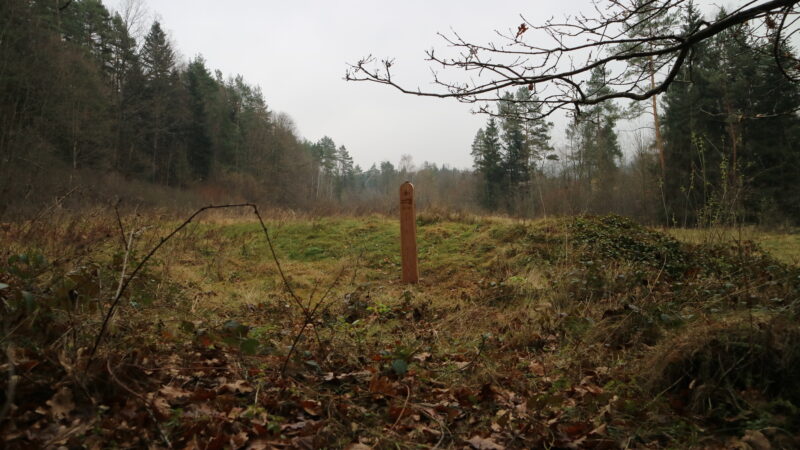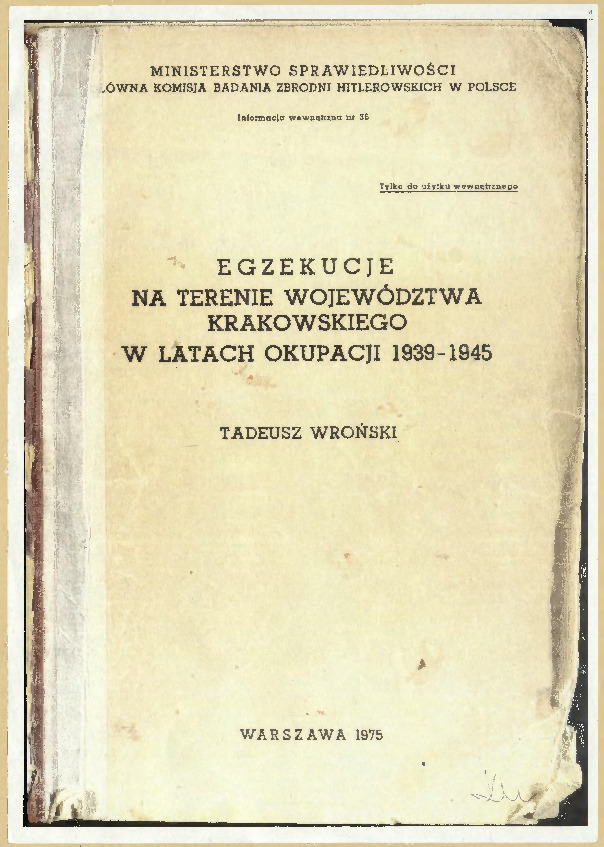Limanowa-Stara Wieś
Borough of Limanowa, Limanowski District, Małopolskie VoivodshipType of place
Jewish cemetery in Limanowa and the forest in Stara WieśInformation about the crime
The Register of Killing Sites and Crimes form the former krakowskie voivodeship (Warszawa, 1975) and the Survey of The Chief Commission for the Examination of German Crimes in Poland (IPN BU 2448/454) record the following crimes in Limanowa:
- On September 12, 1939, 13 people, including 12 Jews, were murdered in the quarries in the Siekierczyna village. Abraham Binder, Naftali Blech, Benzion Blusenstein, Wolf Glashut, Henryk Goldfinger, Markus Goldzbahler, Leizer Lichtscharber, Lowi Sucher, Izaak Rosenwasser, Hirsch Sanger, Meilech Schonberg and Mendel Silberstein were killed on the charge of donating money for purchasing weapons for the underground troops. The bodies were buried at the Jewish cemetery in Limanowa.
- In September 1941 the Germans shot 36 people of Jewish origin. The execution took place in the morning hours. Among the murdered were men, women and children. They were killed in revenge for not paying the contribution imposed on the Jewish community in Limanowa. After exhumation (date unknown) the bodies were taken to a mass grave in Nowy Sącz.
- On July 10, 1942, the German military police shot 10 Jewish people from the ghetto in Limanowa. The victims were: Feiner Eisik with his two daughters from Koszary and Strumpf, a butcher. The bodies were buried in Jewish cemetary in Limanowa in a grave measuring 2x4m.
- On July 12, 1942, the military police murdered 9 people of Jewish origin from ghetto in Limanowa. The questionnaire on executions and mass graves from September 1945 ((IPN GK 163/9) specifies that the execution was a retaliation for the escape of two sisters named Edner from the firing squad on July 10, 1942. The remains of the victims were buried in the Jewish cemetery in Limanowa in a grave measuring 2x4m. Due to lack of pre-war documents it was not possible to compile the complete list of names of the Jews murdered that day. Local people remembered the death of, among others: Blechówna, Lustbardówna, Rosenbaum and Schwarzbrandówna.
The detailed course of events from 10 and 12 July, 1942 that took place in Limanowa can be read in the article „Zagłada limanowskich Żydów. Ku jasnemu słońcu” by Łukasz Połomski: „The story of the Edner sisters who left the ghetto to buy some meat is remarkable. They were suffering from a terrible hunger. When Baumack [the head of the German military police in Limanowa] found out about everything, he arrested 16 Jews involved in it, including Edner sisters. They all got 25 lashes. On may 18 they were taken to the train station and the police car suddenly arrived. A gun was fired and everyone scattered. The Germans shot some of them. Edners hid behind a slope. The bodies were buried in the Jewish cemetery, and the blood in front of the railway station was covered with sand.
Baumack, angry with the Edners, arrested 12 of the most beautiful Jewish women from Limanowa. Among them was a philosophy student, Sara Blech. Policeman and volksdeutsch from Bielsko, Pisch, had his eye on her. As luck would have it, there were two Saras Blechs in Limanowa. Pisch arrested another Sara, uglier one, without his boss Baumack’s knowledge. Meanwhile, the “master of life and death” from Limanowa gave the Edners 24 hours to come forward and save the others. When the time was up, policemen took the Jewish beauties to the cemetery. Then Baumack realised about Sara Blech and ordered to bring the right one – the more beautiful one. He ordered the women to lay down, and the policemen to shoot. Pisch was supposed to shoot “his” Sara. He missed, his hands were shaking. Baumack scolded him and shot her in such a way that he smashed her head.” (www.limanowa.in, accessed November 3, 2020)
- Behind the decision of liquidating the ghetto in Limanowa was the imposition of a contribution on Jewish community in the form of cash in the amount PLN 75.000, several hundred meters of silk fabric, 50 liters of vodka and 50 kg of canned fish. The kehilla failed to meet these demands, and on July 16, 1942, Gestapo officers from Nowy Sącz shot 33 people. Among victims were: Benzion Majer, Beniamin Samueli, Chaim Galdzbahler, Samuel Folkmann, a Jew named Mondstein from the Czech Republic, Schutz and his wife, Mozes, Schutzer, Moryc Mendler, Pessel Schlosser with his wife. The names of the other victims are unknown.
- In July 1942 during the liquidation of the ghetto, an unknown number of Jewish people were shot. The bodies were buried in the Jewish cemetery in one grave measuring 4x6m.
- On August 18, 1942, the ghetto in Limanowa was liquidated. As a part of the liquidation action, 187 men and women were murdered in Stara Wieś, on the outskirts of Limanowa. Among the victims were: the restaurateur Samueli and his wife, Leib Nichtborger and his wife, the tailor Rosenbuth, Birkenbaum and his wife, Aron Stern. The bodies were buried on the land of Wojciech Mąka in Stara Wieś. The bodies were buried at the crime scene.
- On August 29, 1942, a Jewish man, Lieb Berhang, born in 1873, was shot. The body was buried in the Jewish cemetery.
- In September 1942 a Jewish woman, Anna Birkenbaum, born in 1870, was shot. The body was buried in the Jewish cemetery.
- According to a survey of The Chief Commission for the Examination of German Crimes in Poland (IPN BU 2448/453) from 18 August to 5 October 1942, around 190 Jews from Mszana Dolna and limanowski district were held in a wooden barrack in Sowliny, next to the refinery’s residential buildings. They were used for road works, while paving the market square. On October 5, 1942, the naked prisoners were shot. Among the victims are: two Steinhof brothers, Zollman, two Steiners, Rosenbluth, Blech, Rosenbaum, Tiefenbraunner. There is no information on the place of burial.
Commemoration
The place of the grave on the Jewish cemetery in Limanowa was marked with a wooden matzevah in 2020 as part of the project “Reference points – marking 24 Jewish war graves with wooden matzevot ”. The project is an attempt to find a way of marking these places before they can be commemorated. Marking forgotten Jewish war graves with wooden matzevot is a subtle intervention in the landscape reminding about what remains invisible, yet present in the memory of local communities. Being only a temporary commemoration, wooden matzevot invite local communities to discuss and take action, to discover the places, and perhaps to start their own memory practice related to them or to initiate a permanent commemoration.
You can read more about the project here (English below):
https://zapomniane.org/wp-content/uploads/2018/10/MACEWY_punkty-odniesienia_folder.pdf
The project was implemented thanks to the funding from The Association of the Jewish Historical Institute of Poland (Stowarzyszenie Żydowski Instytut Historyczny) and The Matzevah Foundation.
IDENTIFICATION OF THE GRAVE BASED ON NON INVASIVE RESEARCH
On November 20, 2018 a site inspection in Stara Wieś was carried out in the place indicated as a mass grave of several hundred victims (GPS:N49°40.188′ E020°23.837′). The indicated area is a glade located next to the road to Stara Wieś.
The area has a dynamic topography, clearly visible in the LiDAR survey. Visible folds, marked in red, may be traces of depressions associated with collapsed mass graves. Some soil disturbances may be related to the partial exhumation carried out on November 11-12, 1947. There are soil disturbances also in the area around the folds.
The aerial photography query for this area is ongoing.
 fotografia satelitarna 1a Limanowa
fotografia satelitarna 1a Limanowa LiDAR 1 Limanowa
LiDAR 1 Limanowa fotografia 1 lokalizacji Limanowa
fotografia 1 lokalizacji LimanowaSources
Contact and cooperation
We are still looking for information on the identity of the victims and the location of Jewish graves in Limanowa-Stara Wieś. If you know something more, write to us at the following address: fundacjazapomniane@gmail.com.
Bibliography
IPN BU 2448/453, Surveys of The Chief Commission for the Examination of German Crimes in Poland and The Regional Commission for the Examination of German Crimes in Warsaw, collected in 1968-1972. Surveys on the krakowskie voivodeship – VII. Limanowa district.
IPN BU 2448/454, Surveys of The Chief Commission for the Examination of German Crimes in Poland and The Regional Commission for the Examination of German Crimes in Warsaw, collected in 1968-1972. Surveys on the krakowskie voivodeship – VII. Limanowa district.
IPN BU 2448/455, Surveys of The Chief Commission for the Examination of German Crimes in Poland and The Regional Commission for the Examination of German Crimes in Warsaw, collected in 1968-1972. Surveys on the krakowskie voivodeship – VII. Limanowa district.
IPN Kr 502/701, Files in the case of Karol Pisch / Pisz, the officer of Hilfspolizei accused of collaborating with the German authorities, murdering people of Jewish nationality and a member of the Polish underground, 1945-1947.
IPN GK 163/9, Surveys. Executions. Graves. Krakowskie voivodeship; vol. II; Questionnaires about mass executions and mass graves – krakowskie voivodeship, 1939 – 1945.
IPN GK 195 / VII / 8, files on Jewish war graves in Limanowa, scout alert.
Copies of cards from the files of The Chief Commission for the Examination of German Crimes in Poland, copies of cards from the set: Krakow Voivodeship Office, General Department. War Compensation Inspectorate; a copy of the cards from the set: Memories.
Wroński Tadeusz, Executions in the krakowskie voivodeship during the occupation in 1939–1945, Warsaw 1975, pp. 125, 131, 132, 435, 457.
Łukasz Połomski “Extermination of Limanowa Jews. Towards the bright sun …” https://limanowa.in/aktualnosci/zaglada-limanowskich-zydow-ku-jasnemu-sloncu/42528 accessed November 3, 2020)

 Egzekucje na terenie województwa krakowskiego Limanowa
Egzekucje na terenie województwa krakowskiego Limanowa